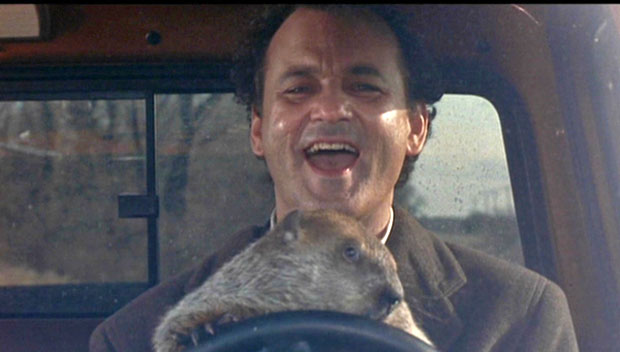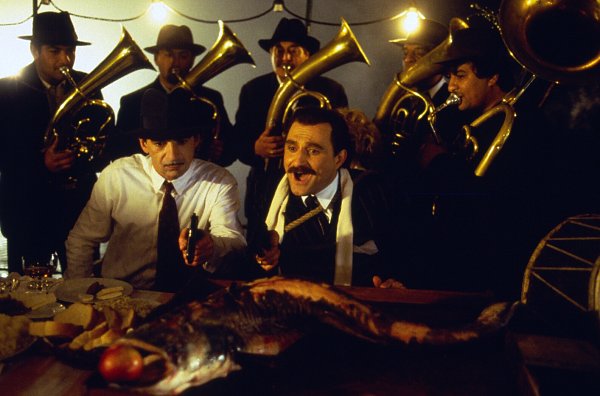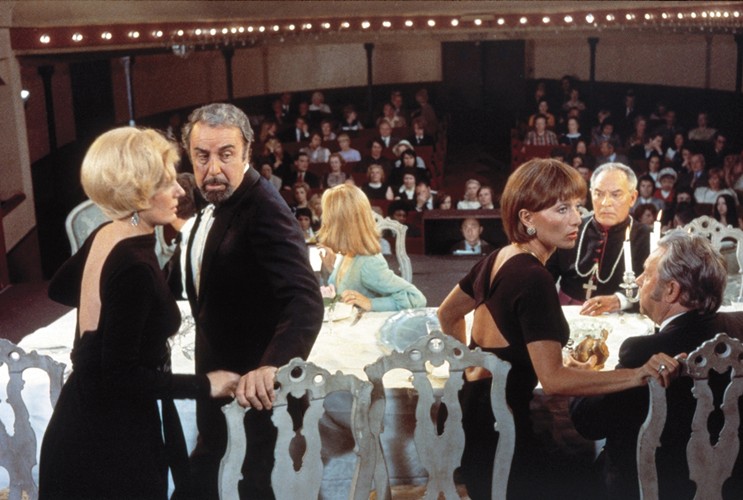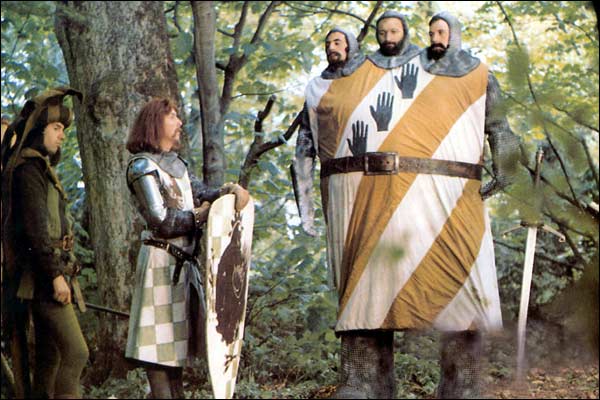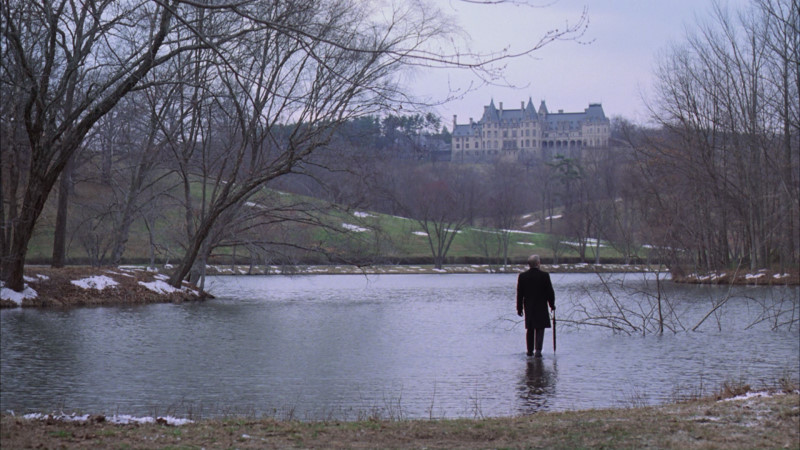5. Groundhog Day (Harold Ramis, 1993)
Although the film stars comedy superstar Bill Murray, its tone and content is much darker and more complex than most of his flicks. Murray stars as Phil Connors, a grumpy weatherman who is mean to everybody. He and his producer Rita, played by Andie MacDowell, go on a trip from Pittsburgh where they are stationed over to Punxsutawney in order to cover the annual Groundhog watch. When driving back after the coverage, they are cut off by a blizzard and forced to stay in Punxsutawney.
The next morning, however, Connors finds that February 2nd has repeated itself and he has to go through the same actions, except nobody else seems to be aware of the time loop. After many days, Connors acts more and more desperate, committing suicide several times and manipulating people but the situation never changes, leading him to rethink his disposition about life.
The number of days that Connors spends in the time loop is not entirely clear but Harold Ramis, the director, said that it totalled at least 10 years, due to the time it takes to master the piano, sculpturing and learning languages. The endless repetition acts as a surreal sort of hell for Connors, showing how humans can break and come to realize their inner identity. While the impossibility of the films events detach it from reality, the main themes are very relatable to real life, creating a bewildering classic film.
4. Underground (Emir Kusturica, 1995)
The Palm D’or winning masterpiece from Serbian auteur Emir Kusturica is a darkly funny, and notably bizarre, depiction of friendship and war. The film follows Blacky and Marko, two debaucherous citizens of Belgrade whose lives are interrupted by the Nazi bombing and occupation. Both members of the communist party, the two help form an underground guerrilla system and weapons storage to help the rebellion forces operating outside of the city.
They also become involved with an actress in the occupied theater, through which much of the film’s themes are explored and pushed. The years go on and their relationship with the communist party varies as the plot travels through World War II on to the Cold War and finally ending in the Yugoslav wars.
There are few directors in cinema history that have created as genre-defying of films as Kusturica, and Underworld is perhaps his most baffling. From the events, it would appear that the film is a war drama, and indeed there are many raw and dark events that would typically be found in that kind of film. The way that Kusturica tells the story of the confused souls in the movie and their journey is much more complicated.
Throughout the film, many seemingly out-of-place instances of absurd comedy and trance-like performances interrupt the serious tone of the plot. The ending in particular, shows the films prevalent surreal atmosphere. Telling the story of Yugoslavia’s transformation over the 20th century, Underground may be unconventional but it certainly effective.
3. The Discreet Charm of the Bourgeoisie (Luis Bunuel, 1972)
One of surreal master Bunuel’s most funny and most famous films, The Discreet Charm of the Bourgeoisie is a completely bizarre and hilarious indictment of aristocratic society. The film‘s plot itself is not very notable. In disjointed scenes, a group of bourgeois couples continue to make dinner plans, but constantly run into problems and cancellations.
The causes of these problems are often impossibly weird occurrences and bizarre actions. There are also many dream sequences of the characters interspersed with the dinner scenes that are even more absurd than the rest of the film.
While Bunuel is famous for making many surreal films that satirize upper class society, including The Exterminating Angel and The Phantom of LIberty, The Discreet Charm of the Bourgeoisie is his masterpiece and greatest comic success. The lack of linear storyline makes the film even more departed from reality,
The connected but scattered vignettes in the film create an incredibly overwhelming effect of lunacy, showing how nonsensical the bourgeois class can be. Their actions are similarly confounding and their movements robotic, suggesting that they don’t have much of a brain and merely follow the guidelines that society sets.
2. Monty Python and the Holy Grail (Terry Gilliam & Terry Jones, 1975)
Monty Python was one of the funniest and most iconic comedy troupes of all time. The British sketch comedy group launched the careers of stars John Cleese, Eric Idle and Michael Palin as well as visionary director Terry Gilliam.The troupe also made other funny films such as The Life of Brian and The Meaning of Life in addition to their legendary show Monty Python’s Flying Circus.
In this film, the group parodies the King Arthur legend through comedic representations of many famed myths and characters. The film takes the format of many connected stories including magicians, evil monsters and other traditional knight tales, all of which have been altered ridiculously.
The familiar sketch-style scenarios of the film allow the actors to shine as they have in their show, with each actor playing multiple characters throughout the film creating a goofy and diverse ensemble of characters. Although British humor has always been quirky to other culture, Monty Python’s unique blend of goofiness with surreal events creates a bewildering atmosphere that strays far from reality.
Some might say that magical content is not surreal but fantastical, however, the film contains more than just magic. Filled with an array of metafictional elements, bizarre animations and other random gags, The Holy Grail is like no other comedy film. It brought British comedy to the forefront of the genre internationally and has grown in popularity ever since, cementing itself as one of the greatest comedies ever made.
1. Being There (Hal Ashby, 1979)
This thought provoking commentary on society is both profound and hilarious. Peter Sellers stars as a simple minded gardener Chance, who’s only knowledge comes from gardening and what he learns on TV, which he watches constantly.
When his employer dies, Chance is left homeless and unemployed. His life changes, however, when he is hit by the car of the rich and powerful businessman Ben Rand. He is taken in by Rand and his wife Eve to recover because, due to his clothes, they mistake him for a distinguished gentleman “Chauncey Gardiner.”
Rand takes a liking to the man, taking his simple, minimalist conversation about gardening as allegorical statements about the country and economy. Rand then introduces him to many other important leaders of the country, including the president of the United States, and Chance becomes a national sensation and the next in line to run the country.
Ashby is typically topical, commenting here on the entire culture of the United States and its complex character, as well as the questionable seriousness of the government. It is also Ashby’s funniest film, with many laugh inducing scenes where people misinterpret Chance’s simple dialogue.
The entire plot is absurd, suggesting that a complete simpleton can accidentally fool the entire country into thinking him a wise leader. The film’s definitive scene, however, is the pinnacle of surreal humor in film, where Chance walks on the water of a pond as if it was commonplace, while the president speaks in the background “Life is a state of mind. “
Author Bio: Matthew Benbenek is an undergraduate Mechanical Engineering student at the University of Wisconsin – Madison. He has a passion for film, music and literature and, when not watching movies, is an amateur director and violin player.
